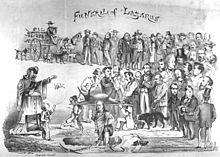Bummer and Lazarus
Recognized for their unique bond and their prodigious rat-killing ability, they became a fixture of city newspapers, were exempted from local ordinances, and immortalized in cartoons.
Bummer was portrayed as the gentleman down on his luck, yet still faithful and conscientious, while Lazarus, the mongrel, was cast in the role of the sly and self-serving fair-weather friend.
[4] The rumor may have arisen because the cartoonist Edward Jump frequently featured the three together, most notably in The Three Bummers which showed Norton eating from a heavily laden buffet table while the dogs wait patiently for scraps.
Norton was apparently outraged when he saw the picture displayed in a shop-front window: the imperial dignity was affronted by the depiction of His Majesty in the company of lowly dogs.
No theatrical performance opened in San Francisco from 1855 to 1880 that three complimentary tickets for the first row of the balcony were not put aside for Bummer and Lazarus and Norton I, Emperor of the United States.Lazarus was killed in October 1863.
In the San Francisco Kaleidoscope, Dickson claimed he was kicked by the horse of one of the city's fire engines,[5] but contemporary accounts say he was poisoned by being given meat laced with "ratbane" after biting a boy.
Jump produced a cartoon of his "Funeral" with Norton as the Pope performing the ceremony and Freddy Coombs—another San Francisco eccentric who claimed to be the reincarnation of George Washington—digging the grave.
The Daily Evening Bulletin featured a long obituary entitled "Lament for Lazarus" in which they praised the virtues of both dogs and recounted their various adventures together.
[1]: 148 Bummer continued alone, although Mark Twain reported a year later in the Daily Morning Call that he had taken a small black puppy under his wing.
Mark Twain produced a eulogy for him in the Virginia City Enterprise which was reprinted in the Californian on 11 November 1865: The old vagrant 'Bummer' is really dead at last; and although he was always more respected than his obsequious vassal, the dog 'Lazarus,' his exit has not made half as much stir in the newspaper world as signalised the departure of the latter.
So the murdered dog was canonized in the newspapers, his shortcomings excused and his virtues heralded to the world; but his superior, parting with his life in the fullness of time, and in the due course of nature, sinks as quietly as might the mangiest cur among us.
Records of the Fine Arts Museums of San Francisco, the institutional parent of the de Young, include undated notations that the specimens were "Destroyed."



